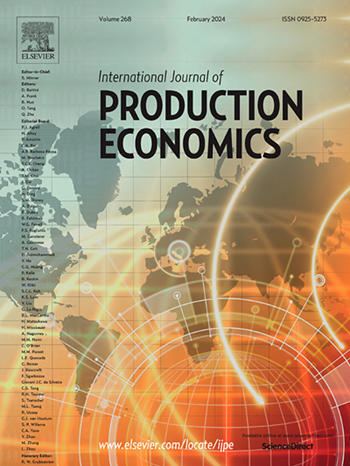研究战略性仓库设计和产品聚类对供应链可行性的影响:一种统一的鲁棒随机规划方法
IF 10
1区 工程技术
Q1 ENGINEERING, INDUSTRIAL
引用次数: 0
摘要
本研究探讨在不确定条件下,策略性仓库设计与产品聚类的整合对供应链生存能力的提升。采用一种新的统一鲁棒随机规划(URSP)模型研究了集成供应链仓库设计和库存分配规划(ISWDIDP)问题,该模型利用了随机规划(SP)处理已知未知不确定性和鲁棒优化(RO)处理未知未知客户需求不确定性的优势。针对四种不同的仓库设计策略和基于K-means算法的两种产品聚类方法,采用人工蜂群算法(ABCA)开发了解决策略。采用实验设计(DoE)框架来评估不同需求变化水平的案例研究中各种可控因素的影响。多种性能指标——包括总成本、短缺成本、供应商和存储区域利用成本、配送成本、订单接收和拣选成本以及存储区域利用率——被用于评估供应链在需求满意度、结构多样性、流程灵活性和高效冗余方面的可行性。此外,一个现实生活中的案例研究,基于纸板制造工厂提出了在一个实际设置验证所提出的方法。研究结果强调了战略仓库设计和产品聚类在深度不确定性下提高供应链可行性的关键作用,表明使用需求和产品尺寸特征的产品聚类与不聚类产品相比显著提高了绩效。本文章由计算机程序翻译,如有差异,请以英文原文为准。
Investigating the impact of strategic warehouse design and product clustering on supply chain viability: A unified robust stochastic programming approach
This study investigates the enhancement of supply chain (SC) viability through the integration of strategic warehouse design and product clustering under uncertainty. An integrated supply chain–warehouse design and inventory-distribution planning (ISWDIDP) problem is examined using a novel Unified Robust Stochastic Programming (URSP) model that leverages the strengths of both stochastic programming (SP) for known-unknown uncertainties and robust optimization (RO) for unknown-unknown uncertainties in customer demand. Solution strategies are developed using an Artificial Bee Colony Algorithm (ABCA) tailored to four distinct warehouse design strategies and two product clustering methods based on the K-means algorithm. A design of experiments (DoE) framework is employed to evaluate the impact of various controllable factors across case studies with different levels of demand variability. Multiple performance metrics—including overall cost, shortage cost, supplier and storage-area utilization cost, distribution cost, order receiving and picking cost, and storage-area utilization rate—are used to assess SC viability in terms of demand satisfaction, structural variety, process flexibility, and efficient redundancy. Moreover, a real-life case study based on a cardboard manufacturing factory is presented to validate the proposed approach in a practical setting. The findings underscore the critical role of strategic warehouse design and product clustering in enhancing SC viability under deep uncertainty, demonstrating that product clustering using both demand and product size features significantly improves performance compared to not clustering products.
求助全文
通过发布文献求助,成功后即可免费获取论文全文。
去求助
来源期刊
CiteScore
21.40
自引率
7.50%
发文量
266
审稿时长
52 days
期刊介绍:
The International Journal of Production Economics focuses on the interface between engineering and management. It covers all aspects of manufacturing and process industries, as well as production in general. The journal is interdisciplinary, considering activities throughout the product life cycle and material flow cycle. It aims to disseminate knowledge for improving industrial practice and strengthening the theoretical base for decision making. The journal serves as a forum for exchanging ideas and presenting new developments in theory and application, combining academic standards with practical value for industrial applications.

 求助内容:
求助内容: 应助结果提醒方式:
应助结果提醒方式:


